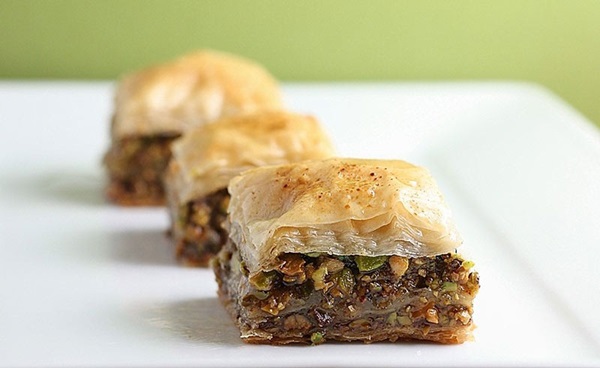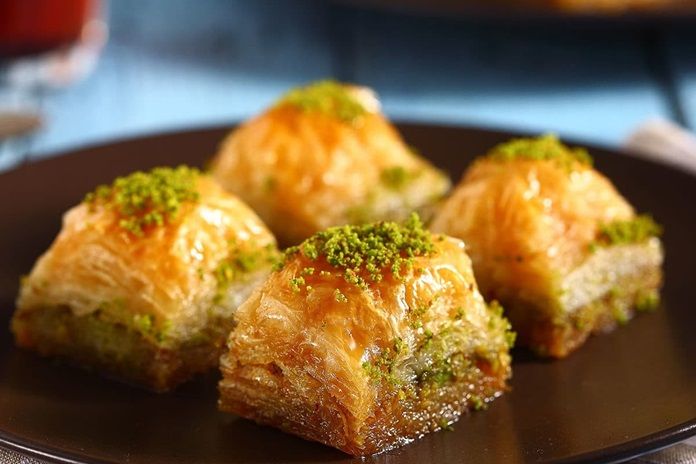National Baklava Day is celebrated on November 17 every year. That day offers a perfect excuse to enjoy this rich, flaky, and sweet dessert that has been a staple in many cultures for centuries. This Mediterranean treat has been loved for centuries, surviving through invasions, tough times, and even world wars. On November 17, we’ll dive into the history of this delicious dessert. Discover local baklava traditions, how it was originally made, and how you can bake your baklava — sticky fingers included.
History of National Baklava Day
Baklava has ancient roots, with references dating back to the 8th century B.C. Many countries claim this sweet treat as their own, as it has been adapted and modified.
The dessert’s features have evolved through different eras and cultures, including Greek, Arabic, Persian, Turkish, and American influences. Variations of baklava range from a flatbread to the thin, flaky pastry we recognize today.
Baklava is made with various nuts like pecans and pistachios, along with almond paste, and is flavored with orange or rose water, honey, or syrup poured over many layers of thin, flaky dough.
The recipe changes with each generation and in different countries, passed down as a cherished family tradition by those who know the secret to making it. However, if you’re curious, you can easily find recipes online.
| 2008 (Turkish patent office granted baklava certificate) |
|
| 2006 (Cyprian baklava in Café Europe led to the so-called “Baklava War”) | In the cultural initiative Café Europe, baklava was chosen to represent Cyprus in the “Sweet Europe” presentation. This led to the “Baklava War,” with Turks proclaiming that baklava is Turkish. |
| 1500s (Turkish invaders bring baklava to Hungary) | In the mid-16th century, during the time of Ottoman Hungary, Turks invaded Hungary multiple times, often eating baklava as a ritual before heading into battle. (Perhaps they were just feeling homesick.) |
| 160 BC (Early version of baklava documented in Italy) | Cato the Elder, a Roman senator and historian, recorded a recipe that resembles today’s baklava. (In this context, “placenta” refers to the layers of thin pastry, and “tracta” is a blend of cheese and honey.) “To shape the placenta: lay down a row of tracta along the entire length of the base dough. Cover this with the tracta mixture from the mortar. Add another layer of tracta on top and continue layering until all the cheese and honey are used up. Finish with a layer of tracta. Place the placenta in the oven and cover it with a preheated lid. Once done, pour honey over the placenta.” |
| 700s BC Assyrians create the earliest-known version of baklava | Their recipe began with thin layers of bread dough, with chopped nuts between each layer, and honey poured over the top after baking. This dish was reserved for special occasions and |

5 Steps To Beautiful Baklava
Step 1: Find your phyllo
Since making phyllo dough from scratch is labor-intensive, it’s easier to use pre-made phyllo dough from most grocery stores. Just make sure you have at least 30 layers.
Step 2: Start layering and brushing
Place a layer of phyllo dough in a large baking pan, brush it with melted butter, then add another layer, brush with butter, and repeat for several more layers.
Step 3: Add nuts and more pastry
Once you’ve layered and buttered several sheets of phyllo, sprinkle a layer of finely chopped nuts (such as walnuts, pistachios, and hazelnuts), then continue layering with phyllo and butter, adding more nuts as you like.
Step 4: Cut your pieces
Before baking, cut the baklava into individual pieces, with a parallelogram (lozenge) shape working well.
Step 5: Bake, pour, and enjoy
Bake at 350°F for about 30 minutes, or until lightly browned. While still hot, pour honey or syrup over the entire pan, letting it soak through all the layers. Allow it to cool slightly before enjoying it.
Conclusion
In conclusion, National Baklava Day on November 17 provides a wonderful opportunity to indulge in and celebrate the rich history of this beloved pastry. From its ancient origins to its evolution across various cultures, baklava has earned its place as a timeless treat.
Whether you’re exploring its historical journey from Assyria to modern-day Turkey, or simply enjoying a slice of homemade baklava, this day highlights the sweet connection between tradition and taste. Embrace the occasion by baking your own batch and savoring each flaky, nutty bite as you honor a dessert that has delighted generations across the globe.
Frequently Ask Question
What is National Baklava Day?
National Baklava Day is celebrated annually on November 17. It’s a day dedicated to enjoying and appreciating baklava, a rich, flaky, and sweet Mediterranean dessert that has been a staple in many cultures for centuries.
What is baklava?
Baklava is a sweet pastry made of thin layers of phyllo dough, filled with chopped nuts such as pistachios, walnuts, or hazelnuts, and sweetened with honey or syrup. It is known for its rich flavor and flaky texture.
What is the history behind baklava?
Baklava has ancient roots dating back to the 8th century B.C. Various cultures, including Greek, Arabic, Persian, Turkish, and American, have adapted and modified the dessert over time. The earliest known version was created by the Assyrians, with recipes evolving through different eras and regions.
How did baklava come to be associated with Turkey?
Turkey is often credited with popularizing baklava, especially the city of Gaziantep, which is known for its baklava. In 2008, Turkey’s patent office granted a geographical indication certificate for Antep Baklava, recognizing it as a unique regional product.
What are some notable historical events related to baklava?
In the 1500s, Turkish invaders introduced baklava to Hungary. In 160 B.C., Roman senator Cato the Elder documented a recipe similar to modern baklava. In the 700s B.C., the Assyrians created an early version of baklava. The “Baklava War” in 2006 occurred when Cypriot baklava was featured in a cultural presentation, leading to disputes over its origin.
You may also like to read, National Homemade Bread Day – November 17, 2024
